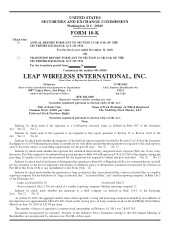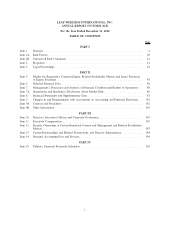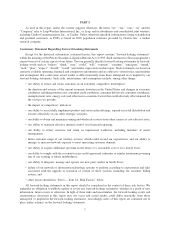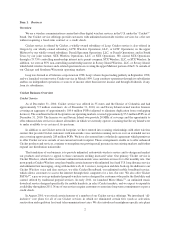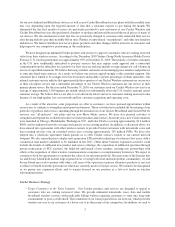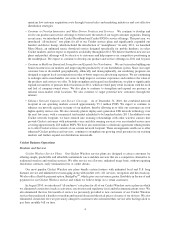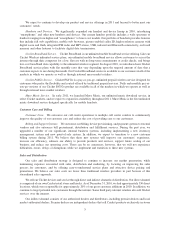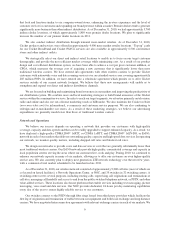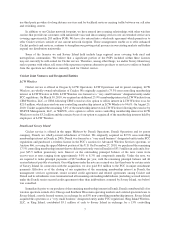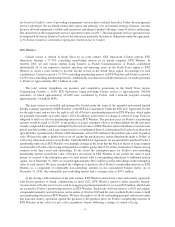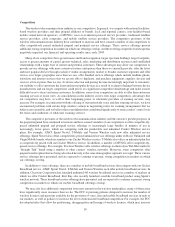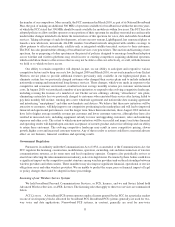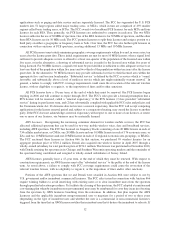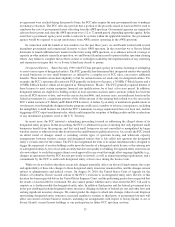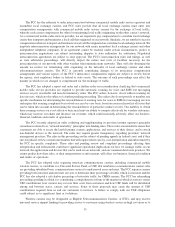Cricket Wireless 2010 Annual Report Download - page 12
Download and view the complete annual report
Please find page 12 of the 2010 Cricket Wireless annual report below. You can navigate through the pages in the report by either clicking on the pages listed below, or by using the keyword search tool below to find specific information within the annual report.that look and function similar to our company-owned stores, enhancing the in-store experience and the level of
customer service for customers and expanding our brand presence within a market. Premier dealers tend to generate
significantly more business than other indirect distributors. As of December 31, 2010, we had approximately 3,700
indirect dealer locations, of which approximately 1,800 were premier dealer locations. We plan to significantly
increase the number of our premier dealer locations in 2011.
We also conduct indirect distribution through national mass-market retailers. As of December 31, 2010,
Cricket products and services were offered in approximately 4,900 mass-market retailer locations. “Top-up” cards
for our Cricket Broadband and Cricket PAYGo services are also available in approximately 6,500 convenience
stores and other indirect outlets.
We strategically select our direct and indirect retail locations to enable us to focus on our target customer
demographic and provide the most efficient market coverage while minimizing cost. As a result of our product
design and cost efficient distribution system, we have been able to achieve a cost per gross customer addition, or
CPGA, which measures the average cost of acquiring a new customer, that is significantly lower than most
traditional wireless carriers. We have entered into agreements with other wireless carriers to provide Cricket
customers with nationwide voice and data roaming services over an extended service area covering approximately
285 million POPs. In addition, we have entered into a wholesale agreement which permits us to offer Cricket
services outside of our current network footprint. We believe that these new arrangements will enable us to
strengthen and expand our direct and indirect distribution channels.
We are focused on building and maintaining brand awareness in our markets and improving the productivity of
our distribution system. We combine mass and local marketing strategies to build brand awareness of the Cricket
service within the communities we serve. In order to reach our target segments, we advertise primarily on television,
radio and online and also use out-of-home marketing (such as billboards). We also maintain the Cricket website
(www.mycricket.com) for informational, e-commerce and customer service purposes. We are also continuing to
redesign and re-merchandize our stores. As a result of these marketing strategies, we believe our advertising
expenditures are generally much lower than those of traditional wireless carriers.
Network and Operations
We believe our success depends on operating a network that provides our customers with high-quality
coverage, capacity and data speeds and that can be readily upgraded to support enhanced capacity. As a result, we
have deployed a high-quality CDMA2000»1xRTT, or CDMA 1xRTT, and CDMA2000»1xEV-DO, or EvDO,
network in each of our markets that delivers outstanding quality, capacity and high-speed data services. In operating
our network, we monitor quality metrics, including dropped call rates and blocked call rates.
We design our networks to provide voice and data services at costs that are generally substantially lower than
most traditional wireless carriers. Our EvDO networks provide high quality, concentrated coverage and capacity in
local population centers serving the areas where our customers live, work and play. During 2010, we continued to
enhance our network capacity in many of our markets, allowing us to offer our customers an even higher-quality
service area. We also currently plan to deploy next-generation LTE network technology over the next few years,
with a commercial trial market scheduled to be launched in late 2011.
As of December 31, 2010, our wireless network consisted of approximately 9,000 cell sites (most of which are
co-located on leased facilities), a Network Operations Center, or NOC, and 35 switches in 32 switching centers. A
switching center serves several purposes, including routing calls, supervising call originations and terminations at
cell sites, managing call handoffs and access to and from the public switched telephone network, or PSTN, and other
value-added services. These locations also house platforms that enable services including text messaging, picture
messaging, voice mail and data services. Our NOC provides dedicated, 24 hours per day monitoring capabilities
every day of the year to ensure highly reliable service to our customers.
Our switches connect to the PSTN through fiber rings leased from third party providers which facilitate the
first leg of origination and termination of traffic between our equipment and both local exchange and long distance
carriers. We have negotiated interconnection agreements with relevant exchange carriers in each of our markets. We
6



